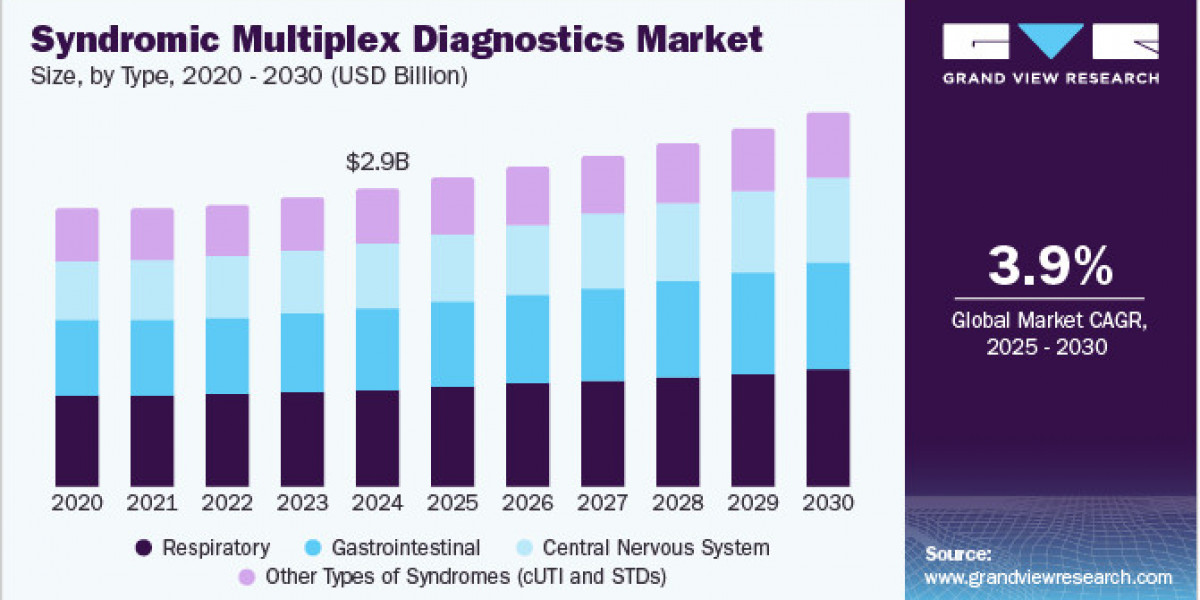The global syndromic multiplex diagnostics market size was estimated at USD 2.92 billion in 2024 and is expected to expand at a CAGR of 3.91% from 2025 to 2030. The growth of the market is attributed to the rising demand for rapid, accurate diagnostics, advancements in diagnostics technologies, and rising prevalence of infectious diseases globally. Increasing incidences of infectious diseases such as respiratory infections, gastrointestinal diseases, and STIs among others have fueled the demand for syndromic testing. According to the World Health Organization (WHO), in 2023, tuberculosis (TB) caused 1.25 million deaths, including 161,000 among people with HIV. Moreover, an estimated 10.8 million people developed TB, including 6.0 million men, 3.6 million women, and 1.3 million children, affecting all countries and age groups. Such rise in infectious diseases increases the demand for effective diagnostics solutions thereby driving market growth.
Advancements in molecular diagnostics have also significantly driven the growth of the market. Next-generation sequencing and advanced Polymerase Chain Reaction (PCR) technologies have enhanced the sensitivity and specificity of multiplex assays, making them highly reliable. For instance, in September 2024, Roche launched the Cobas Respiratory Flex test, utilizing novel TAGS technology for syndromic multiplex PCR testing. This test can identify up to 15 respiratory pathogens from a single sample, including influenza and SARS-CoV-2. It enhances diagnostic efficiency by providing rapid results without needing additional samples, thereby streamlining laboratory processes and improving patient care. Such advancements significantly improve patient outcomes and drive the adoption of these diagnostics solutions in different healthcare settings.
Get a preview of the latest developments in the Syndromic Multiplex Diagnostics Market; Download your FREE sample PDF copy today and explore key data and trends

Furthermore, increasing investments in research and development by market players are driving innovation, leading to the introduction of assays capable of detecting emerging pathogens and mutations, addressing critical unmet needs in healthcare. For instance, in September 2024, Korea’s Seegene partnered with Springer Nature to offer research grants aimed at advancing syndromic PCR diagnostic assays. The initiative seeks to enhance innovation in molecular diagnostics, encouraging researchers to develop new methodologies and applications. This collaboration indicates the importance of enhancing diagnostic capabilities for emerging infectious diseases, thereby contributing significantly to public health advancements. Such increasing investments and focus on R&D can lead to the development of innovative diagnostics solutions and drives market growth over the forecast period.
Detailed Segmentation
Product Insights
The respiratory accounted for the largest revenue share of 32.70% in 2024 owing to the high prevalence and rapid spread of respiratory infections, coupled with the crucial need for accurate diagnosis. According to the WHO, seasonal influenza affects approximately one billion people worldwide each year, leading to 3-5 million cases of severe illness and resulting in 290,000 to 650,000 respiratory deaths annually. Moreover, the aging population, which is more vulnerable to respiratory illnesses, coupled with the increasing availability of effective respiratory diagnostics solutions further contributes to the segment growth.
End Use Insights
The diagnostics laboratories segment dominated the end use segments with the largest market share in 2024 due to their extensive infrastructure, high throughput capabilities, and crucial role in providing accurate, rapid, and comprehensive testing. Diagnostic laboratories also benefit from established partnerships with hospitals, clinics, and research institutions, increasing their need for effective diagnostics tools. Furthermore, the diagnostics expertise offered by these facilities significantly increases the patient footfall, further increasing demand for syndromic diagnostics tools in these facilities.
Regional Insights
North America syndromic multiplex diagnostics market dominated the market and accounted for a 41.85% share in 2024. The syndromic multiplex diagnostics industry in North America is experiencing significant growth driven by the presence of key market players, evolving regulatory landscape, developed healthcare infrastructure, and increasing prevalence of various infectious diseases. For instance, according to the U.S. Department of Health & Human Services, approximately 1.2 million people in the U.S. are living with HIV, with 13% unaware of their status. In 2022, an estimated 31,800 individuals acquired HIV, and 37,981 people aged 13 and older were diagnosed with the virus across the U.S. and its territories. This high prevalence of infectious diseases significantly increases the demand for rapid diagnostics technology, which contributes to the market growth in the region.
Key Syndromic Multiplex Diagnostics Company Insights
Some of the key players operating in the market include Abbott Laboratories, Thermo Fisher Scientific, Inc., Abbott Laboratories, F. Hoffmann-La Roche Ltd and others. The market is highly competitive, with a large number of manufacturers accounting for a majority of the share. New source developments, mergers and acquisitions, and collaborations are some of the major strategies adopted by these players to counter the high competition.
Key Syndromic Multiplex Diagnostics Companies:
The following are the leading companies in the Syndromic Multiplex Diagnostics market. These companies collectively hold the largest market share and dictate industry trends.
- Abbott Laboratories
- Thermo Fisher Scientific, Inc.
- F. Hoffmann-La Roche Ltd
- Qiagen
- bioMérieux
- DiaSorin S.p.A (Luminex Corporation)
- Hologic, Inc.
- Becton, Dickinson and Company (BD)
- Applied BioCode
- QIAGEN
- Curetis GmbH
Syndromic Multiplex Diagnostics Market Segmentation
For this report, Grand View Research has segmented the syndromic multiplex diagnostics market on the basis of type, and end use.
Syndromic Multiplex Diagnostics Type Outlook (Revenue, USD Million; 2018 - 2030)
- Respiratory
- Gastrointestinal
- Central Nervous System
- Other Types of Syndromes (cUTI and STDs)
Syndromic Multiplex Diagnostics End Use Outlook (Revenue, USD Million; 2018 - 2030)
- Hospitals
- Diagnostic Laboratories
- Others
Regional Outlook (Revenue in USD Million, 2018 - 2030)
- North America
- U.S.
- Canada
- Mexico
- Europe
- UK
- Germany
- France
- Italy
- Spain
- Sweden
- Denmark
- Norway
- Asia Pacific
- Japan
- China
- India
- Australia
- South Korea
- Thailand
- Latin America
- Brazil
- Argentina
- Middle East and Africa
- Saudi Arabia
- South Africa
- UAE
- Kuwait
Curious about the Syndromic Multiplex Diagnostics Market? Download your FREE sample copy now and get a sneak peek into the latest insights and trends.









